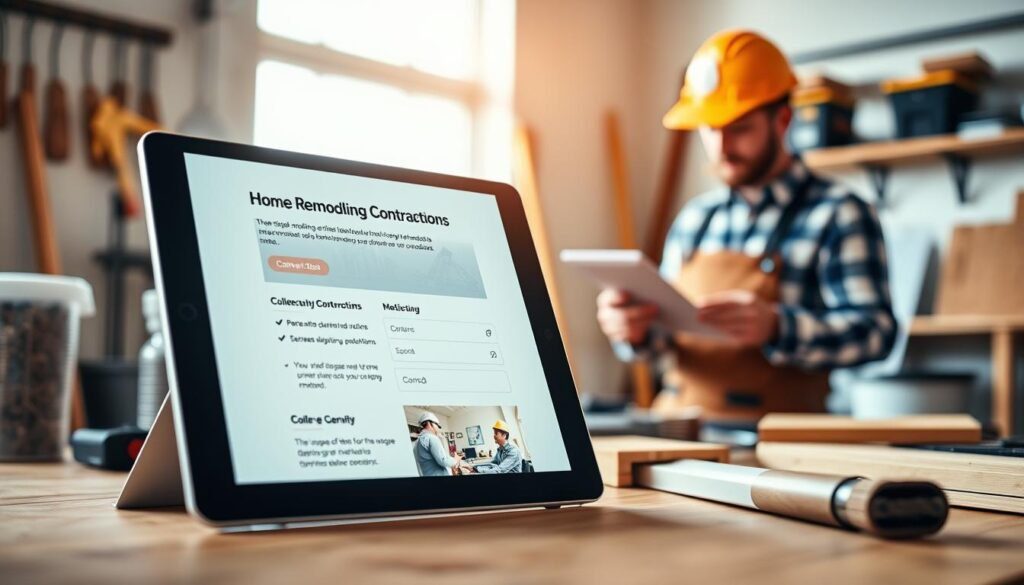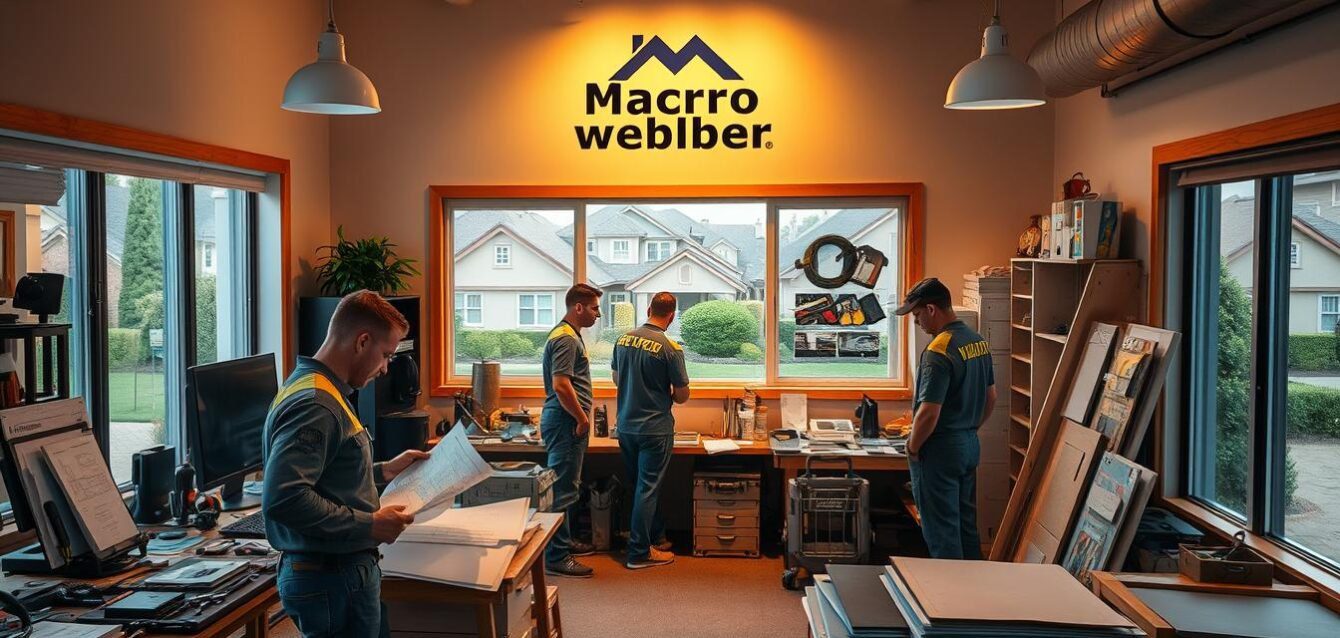Did you know 72% of homeowners search online before hiring a professional for renovation projects? If your business isn’t visible when potential clients look, you’re missing out. Companies like Macro Webber (+91 353 405-7665) have tripled their leads by optimizing their digital presence.
With 64% of searches happening on mobile devices, a well-structured online profile ensures you appear in top results. Kitchen and bath specialists need more than word-of-mouth—they need search engines to work for them.
Simple changes, like updating service pages or refining your Google Business Profile, can make a big difference. The best part? These tactics often cost less than traditional ads while delivering better results.
Key Takeaways
- Most homeowners research contractors online before making contact.
- Mobile-friendly profiles are essential for local visibility.
- Optimizing service pages can boost search rankings.
- Case studies show significant lead growth with proper implementation.
- Google Business Profile updates improve local discovery.
Why Local SEO Matters for Your Remodeling Business
Visibility in local searches can make or break your business. Homeowners increasingly rely on digital tools to find trusted professionals. If your company doesn’t appear when they search, you’re invisible to potential clients.
How Homeowners Find Contractors Online
Most searches start with phrases like “kitchen remodeler near me” or “bathroom renovation costs.” The #1 spot in search engine results gets 32% of clicks, while page 2 listings receive just 2%. This gap highlights why ranking matters.
Branded searches (e.g., your business name) convert 50% higher than generic terms. However, 80% of initial searches are unbranded—meaning your presence must capture attention before clients know you.
Search Rankings Drive Quality Leads
Contractors with complete Google Business Profiles receive 5x more calls. Localized content boosts conversions by 40% by answering specific questions like “best materials for small bathrooms.”
- Reviews matter: Listings with 4.8+ stars qualify for featured snippets.
- Schema markup helps capture 30% more SERP features like FAQs.
- Seasonal trends show spring spikes for outdoor projects.
Clients in “I want to hire” mode spend 3x more than browsers. Optimizing for these micro-moments ensures your results attract ready-to-act clients.
Setting Up Your Google Business Profile for Maximum Visibility
Inconsistent business details online can cost you nearly 40% of potential leads. A complete and optimized Google Business Profile ensures your local business appears when clients search for services like yours.
Step-by-Step Profile Creation
Start by claiming or creating your profile. Use your exact business name (e.g., Macro Webber), address, and a direct phone number. Avoid tracking numbers—Google penalizes them.
Choose relevant service categories, such as “Bathroom Remodeler” or “Kitchen Contractor.” These help match your presence to search queries.
Optimizing Service Descriptions
Write clear, keyword-rich descriptions. For example: “Macro Webber offers premium kitchen renovations in [City], with free estimates. Call (353) 405-7665.” Link to your website for portfolios or reviews.
NAP inconsistencies cause 38% ranking drops for local businesses.
The Importance of NAP Consistency
NAP (Name, Address, Phone) must match across all platforms. Tools like BrightLocal scan 50+ directories for errors. Fix duplicates or merged listings promptly.
- Phone number formatting: Use the +1 country code (e.g., +1 353 405-7665).
- Submit to trusted directories (Houzz, BBB) to boost accuracy.
- Add NAP to email signatures for brand consistency.
Schema markup further enhances visibility by tagging your business data for search engines. This improves Knowledge Panel accuracy, making your local business stand out.
Finding the Right Keywords to Attract Local Clients
Local searches often begin with specific phrases—knowing which ones matter can transform your visibility. Homeowners type queries like “bathroom remodel [City]” or “kitchen renovation costs near me.” These terms signal intent to hire, making them gold for your website.
Identifying High-Intent Remodeling Search Terms
Prioritize phrases with commercial intent. For example, “best bathroom tiles for small spaces” suggests research, while “affordable bathroom remodeler [City]” indicates readiness to hire. Google Keyword Planner reveals 1,200 monthly searches for the latter in many markets.
Scrape Google Autocomplete for real-time ideas. Typing “how to hire a…” surfaces questions like “contractor with free estimates.” AnswerThePublic clusters these into themes—ideal for content planning.
Location-Based Keyword Strategies
Hyperlocal modifiers boost relevance. Include neighborhood names (“Downtown loft renovations”) or landmarks (“near Main Street”). Tools like LSIGraph generate geo-specific variants, such as “licensed kitchen remodeler in [City].”
Tools for Keyword Research
Compare free and paid options:
- Ubersuggest: Tracks volume and difficulty for starter terms.
- SEMrush: Filters by geo-targeting in Keyword Magic Tool.
- Google Search Console: Shows actual queries driving traffic to your website.
Over-optimization triggers penalties. Maintain a 1–2% keyword density.
AI tools like SEO.AI streamline content creation but verify outputs for natural phrasing. Track rankings in spreadsheets, noting seasonal trends (e.g., “outdoor deck builder” peaks in spring).
Creating Service Pages That Convert Visitors to Calls
Your service pages act as digital showrooms for potential clients. They need to answer questions, showcase expertise, and guide visitors toward contacting you. Companies like Macro Webber (example) use structured layouts to highlight projects and simplify decision-making.

Essential Pages Every Contractor Needs
Start with core service pages: kitchen renovations, bathroom remodels, and custom additions. Each page should include:
- Detailed descriptions of materials and timelines.
- Before-and-after images with alt text like “modern kitchen remodel in Chicago.”
- Embedded videos—portfolio pages with videos retain visitors 53% longer.
Writing Compelling Service Descriptions
Use a challenge/solution format. For example:
“Outdated layouts waste space. Our team reconfigures kitchens to add 30% more storage while keeping costs transparent.”
Include client testimonials mid-page to build trust. Schema markup for reviews boosts visibility in search snippets.
Showcasing Your Portfolio Effectively
Avoid stock photos. Instead, use high-quality images with descriptive filenames (e.g., “luxury-bathroom-remodel.jpg”). Follow this checklist:
| Image Optimization Task | Best Practice |
|---|---|
| Filenames | Use hyphens, not underscores (e.g., “custom-cabinets.jpg”). |
| Alt Text | Describe the image and include location (e.g., “sleek bathroom vanity in Boston”). |
| Compression | Reduce file size to under 300KB without losing quality. |
Plugins like Envira Gallery help organize projects. For advanced features, consider 3D modeling or virtual tours to stand out.
Finally, add a lead magnet—like a free design guide—to capture visitor emails. This turns casual browsers into engaged leads.
Blog Content That Builds Trust and Authority
Quality content answers homeowner questions before they even ask. Contractors publishing weekly grow traffic 126% faster. Your blog becomes a go-to resource, turning readers into clients.
Answering Common Homeowner Questions
Address pain points like “cost vs. value of bathroom upgrades” or “permits needed for kitchen expansions.” Use case studies to show real solutions. For example:
“Adding a walk-in shower increased resale value by 12% for our downtown clients.”
Localizing Your Content Strategy
Hyperlocal details matter. Highlight neighborhood trends, like “mid-century modern updates in Austin” or “small-space solutions for NYC apartments.” This boosts relevance in local searches.
- Interview local suppliers for material insights.
- Feature client projects with geo-tagged images.
- Update seasonal guides (e.g., “holiday-ready kitchen remodels”).
Content Calendar Ideas
Plan ahead to save time. Try this 12-month framework:
| Quarter | Theme |
|---|---|
| Q1 | New Year renovation trends |
| Q2 | Outdoor living spaces |
| Q3 | Back-to-school home offices |
| Q4 | Holiday hosting upgrades |
Repurpose blog posts into videos or infographics. Review analytics monthly to refine your marketing approach.
On-Page Optimization Techniques for Remodelers
Your website’s structure directly impacts how search engines rank your services. Simple tweaks to titles, images, and links can push your page to the top of local results. Here’s how to refine each element.
Crafting Effective Title Tags and Meta Descriptions
Keep titles under 60 characters. Include location and service, like “Kitchen Remodeling in Austin | Free Estimates.” Meta descriptions should entice clicks—answer a pain point briefly.
Example: “Struggling with a cramped bathroom? Our space-saving remodels add 25% more storage. Call today!”
Optimizing Project Photos for Search
Use original images with descriptive filenames (e.g., “modern-kitchen-remodel-chicago.jpg”). Alt text helps visually impaired users and boosts rankings:
- Do: “Custom blue-tiled shower in downtown Dallas.”
- Don’t: “IMG_1234.jpg.”
Strategic Internal Linking
Sites with strong linking get 40% more pages indexed. Link related content, like connecting a blog post about “small bathroom ideas” to your bathroom remodel page.
Anchor text should be natural—avoid “click here.”
Tools like Screaming Frog identify broken links. Fix them to keep your site’s authority intact.
Technical SEO Foundations You Can’t Ignore
Technical SEO separates thriving businesses from invisible ones in search results. While flashy designs attract clients, your website’s backend determines whether search engines can find and rank your services. Ignoring these elements means losing 30% of potential clicks to competitors.
Mobile Responsiveness Checklist
Google’s mobile-first indexing prioritizes phone-friendly sites. Test yours with:
- Google’s Mobile-Friendly Test: Fix rendering issues like oversized images.
- Tap targets: Buttons should be 48px apart to prevent misclicks.
- Viewport settings: Ensure content scales across devices.
Site Speed Optimization
Pages loading slower than 3 seconds lose 53% of visitors. Optimize by:
- Compressing images via TinyPNG (under 300KB).
- Enabling browser caching to reduce reload times.
- Minifying CSS/JavaScript with tools like WP Rocket.
Improving speed from 5s to 2s boosts conversions by 15%.
Schema Markup for Contractors
Structured data helps search engines display rich snippets. Key types:
- LocalBusiness schema: Add your NAP, hours, and service areas.
- Review snippets: Show star ratings directly in results.
- FAQPage: Answer common questions like “permits for basement remodels.”
Use Google’s Structured Data Markup Helper to generate code. Avoid stuffing—penalties apply for misleading markup.
Building Local Backlinks to Boost Your Rankings
Backlinks from trusted local sources act like votes of confidence for your business. When reputable websites link to yours, search engines view you as an authority in your area. This directly impacts how high you appear in results.
Strategic Partnerships With Complementary Businesses
Team up with interior designers, architects, or hardware stores. Offer to exchange guest content or co-host workshops. These collaborations often lead to natural backlinks.
For example, a kitchen remodeler might partner with:
- Appliance retailers for product showcase pages
- Real estate agencies for home improvement guides
- Local interior design blogs for expert interviews
Maximizing Local Directory Listings
Beyond basic listings, leverage niche directories specific to construction and renovation. Focus on platforms like:
- HomeAdvisor ProFinder
- Angi (formerly Angie’s List)
- Houzz Pro
Ensure your profiles include detailed content about services and link back to your site. Consistent NAP (Name, Address, Phone) information builds trust.
Earning Media Coverage That Matters
Press mentions increase domain authority by 18%. Position yourself as an expert source for home improvement stories.
Local newspapers often feature “best of” lists or seasonal renovation guides.
Try these marketing tactics:
- Submit projects for design awards with media partnerships
- Offer expert commentary on housing market trends
- Share unique case studies with before/after data
Create a media kit with high-res images and project highlights. Follow up politely with reporters covering real estate or lifestyle beats.
Remember: Avoid paid link schemes. Google penalizes artificial backlink networks. Focus on earning genuine recognition through quality work and community engagement.
Online Reviews and Their Impact on SEO
Your reputation online can determine whether clients choose you over competitors. Positive feedback builds trust, while unanswered criticism may deter potential customers. Studies show responding to reviews increases new feedback volume by 12%.
Encouraging Satisfied Clients to Share Feedback
Make it easy for happy clients to leave reviews. Send follow-up emails with direct links to your Google or Yelp profiles. Personalize requests:
- Include their project name (“How’s your new kitchen remodel?”).
- Offer a thank-you discount for future services.
- Use tools like Podium to automate requests.
Responding Professionally to All Feedback
Every response reinforces your business’s professionalism. Negative reviews require tact—avoid defensiveness. Follow this framework:
| Review Type | Response Template |
|---|---|
| Negative | “We regret your experience didn’t meet expectations. Please call (555) 123-4567 to discuss how we can make it right.” |
| Positive | “Thank you! We loved working on your bathroom upgrade and hope you’re enjoying it.” |
Legal tip: Never disclose project specifics publicly. Move sensitive discussions offline.
Tools like ReviewTrackers analyze sentiment trends. Monitor competitors’ feedback to identify gaps in your presence. Consistency in tone and timely replies strengthen credibility.
Essential SEO Tools for Home Remodeling Contractors
The right digital tools can transform how clients discover your services. Whether you’re starting or scaling, these platforms help refine your marketing strategy. Focus on solutions that save time and improve accuracy.
Free Tools for Beginners
Budget-friendly options provide critical insights without upfront costs. Google’s suite is a top choice:
- Google Keyword Planner: Identifies local search trends for terms like “bathroom remodel costs.”
- Google Search Console: Tracks which queries drive traffic to your site.
- AnswerThePublic: Visualizes common homeowner questions by region.
Free versions often limit data but reveal enough to prioritize efforts. For example, Ubersuggest’s tier shows basic competition levels for keywords.
Advanced Tools for Growing Businesses
Paid platforms offer deeper analysis for established businesses. Consider these investments:
| Tool | Best For |
|---|---|
| SEMrush | Tracking competitors’ backlinks and ad strategies. |
| SurferSEO | Optimizing content structure with real-time suggestions. |
| BrightLocal | Managing local citations and review monitoring. |
Ahrefs tracks 10B keywords globally—ideal for spotting regional demand shifts.
Specialized tools like Hotjar reveal how visitors navigate your site. Heatmaps show where clicks cluster, helping redesign high-exit pages. Avoid vanity metrics (e.g., social likes) unless they correlate with leads.
Tracking Your SEO Progress Over Time
Data-driven decisions separate thriving businesses from stagnant ones. Monthly adjustments based on analytics boost ROI by 23%. Focus on metrics that reveal gaps and opportunities.
Key Metrics to Monitor
Start with these core indicators:
- Organic traffic: Track visits from non-paid search results.
- Conversion rates: Measure how many visitors call or request estimates.
- Bounce rates: High exits signal mismatched content.
Tools like Google Analytics simplify trend analysis. Set up custom dashboards to save time.
Adjusting Your Strategy Based on Data
Use A/B testing to refine high-value pages. For example, try two versions of a service page:
Version A highlights pricing; Version B focuses on portfolio images. Run for 30 days to compare results.
Seasonal shifts matter. Allocate more marketing budget to outdoor projects in spring. Update content every 90 days to stay relevant.
| Adjustment Trigger | Action Plan |
|---|---|
| Algorithm update | Audit backlinks, fix broken pages. |
| Competitor overtakes rankings | Analyze their backlinks, refresh meta tags. |
Avoid knee-jerk reactions. Trends require 3–6 months of data before pivoting.
When to Consider Professional SEO Help
Growing your business online requires expertise beyond basic website setup. If you’re spending hours on digital marketing without seeing results, it might be time to bring in specialists. Nearly half of all companies change providers within 18 months—choosing the right partner from the start saves time and money.

Signs You’re Ready to Outsource
Watch for these red flags in your digital services:
- Your site traffic plateaus despite regular content updates
- Competitors consistently outrank you for key terms
- Technical issues like crawl errors go unresolved for weeks
- You lack time to implement recommended changes
“Contractors who outsource to specialists see 3x faster ranking improvements than DIY efforts.”
Questions to Ask Potential SEO Partners
Vet providers thoroughly with this checklist:
- Industry experience: Request case studies from similar remodeling businesses
- Communication standards: How often will they report progress?
- Ethical practices: Do they follow Google’s guidelines?
- Contract terms: What’s the cancellation policy?
Always check references—ask about campaign transparency and problem-solving approaches. Avoid firms guaranteeing top rankings; ethical providers discuss realistic timelines instead.
| Red Flag | Solution |
|---|---|
| Vague strategies | Request detailed quarterly plans |
| No penalty recovery examples | Verify past successful appeals |
Set clear expectations upfront about reporting formats and key performance indicators. The right partner becomes an extension of your team, not just another vendor.
Conclusion: Your Action Plan for Local SEO Success
Now is the time to turn digital strategies into real leads. Contractors implementing these tactics see a 200% increase in calls within months. Start with Google Business Profile updates and review management—these deliver fast wins.
Commit to consistent content production. Monthly blogs and refreshed service pages keep your business visible in local search results. Technical fixes, like mobile optimization, prevent traffic leaks.
Track progress every 30 days. Adjust based on KPIs like organic traffic and conversions. Stagnation hurts growth—act now to outpace competitors.
Need help? Macro Webber offers free consultations. Call +91 353 405-7665 or visit www.macrowebber.com. Your next project could begin with one click.



